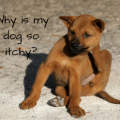Dogs shake themselves for lots of reasons, such as to alleviate itchy skin, to dry off, and even to relieve tension. But, when a dog vigorously shakes just his head back and forth, chances are you could be looking at an ear infection. In addition to your dog shaking his head, there are other signs and symptoms of ear infection you can be on the lookout for.
Telltale Sign My Dog Has An Ear InfectionMy dog, I learned, creates an ear scratching post, by digging his ear into the carpet while walking across the room at the same time. In addition, he’s not quiet about it, he groans through the process, and then proceeds to rub his ear across every piece of furniture in the room. Next, comes the vigorous head shaking, both of his floppy ears loudly slapping from side to side. But, I wouldn’t want it any other way. Without these telltale signs, I wouldn’t be alerted to the issue. Since dog ear infections can be itchy, uncomfortable, and even painful, it’s not something I want to hold off on resolving. Signs & Symptoms of Dog Ear Infection |
- Shaking head back and forth
- Rubbing side of head/ears against the floor, furniture, or walls
- scratching ears with paws
- discharge from the ear
- inside of ear is red, crusty, or swelling
- odor coming from inside the ear
- hearing loss
- loss of balance
Types & Causes of Dog Ear Infection
There are many types of ear infection, but the most common are an overgrowth of yeast, or bacteria. Other ear infections can come from ear mites, flea bites, or allergens in the environment including mold, dust, or pollens.
- Floppy-eared dogs can be more prone to getting ear infections since the ears are covered, and moisture within the ear canal cannot dry out as easily.
- Dogs who swim a lot can get more ear infections, since wet ears is one of the very things that cause infection. In addition, a portion of a dog’s ear canal runs vertically, which can trap water and debris within the ear canal, instead of moving it upward and out, leading to infection. Drying a dog’s ears after swimming can significantly help.
- Dogs who get groomed can also be prone to ear infections. As a preventative measure, groomers should place cotton in dogs ears to prevent water and moisture from entering the ear canal. Also, some groomers will pluck hair out of the ear. There is a bit of controversy over whether or not this process is actually harmful, and may be contributing to ear infection by leaving tiny openings in the skin for bacteria to settle and grow, and also leave the ears in an irritated state. In contrast, some groomers believe the process to be beneficial, saying that excessive hair growth in the ears prevents air flow, and in turn can trap moisture in the skin folds causing the growth of bacteria that way. Possibly it is beneficial for some dogs if done properly, however, in general dogs don’t like the feeling of ear plucking, and my vet has recommended that I tell my groomer to stop this process. For my situation, I’ve decided to stick with her recommendation for future grooming sessions. As an added preventative measure, my vet has also recommended bringing along a sample sized ear cleanser so the groomer can clean the ears immediately after the grooming session.
Treatment for Your Dog’s Ear Infection
It is important to seek treatment with your veterinarian since ear infections are not only incredibly uncomfortable for your dog, but a deep infection may also cause permanent hearing loss. In addition, ear infections usually cause dogs to frequently shake their heads, which can lead to something called aural hematoma. This is when the blood vessels in the ear flap break, which is a painful experience for a dog, and requires surgery to correct.
To determine the proper treatment for your dog, your vet will use a magnifying instrument to peer into the ear canal. Depending on the type of organism found to be causing the ear infection, the proper medication can then be prescribed. In small cases, surgery or an ear-flushing procedure may be required, however, most times, treatment consists of a simple ear cleaning at the vets office and medication to be given at home.







Carol- This is a really important topic! I also run a dog website and a lot of activity that people find to be funny, cute or just quirky in their dog can sometimes mean that they need help with something. Just recently I did an article on “head pressing” and I got so many responses in regards to people not knowing how important it was for them to know what was going on.
This is a great article and has a lot of great information, thank you for sharing!
Yes, I agree, many things dogs do look so cute, but carry meanings beyond what people are aware of. Thanks for your comment. Nice to hear you have a dog website too. 🙂
Hi Carol,
This is really a great article. I had a room mate whose dog had floppy ears and was prone to ear infections. The vet said it was because the dog had allergies and that was why he was getting the ear infections. So once a week she had to scrub out his ears, which he hated, and I had to help her hold him incase he got too upset with the cleaning. He never did, but you could tell he thought it wasn’t fun.
Hi Jessica,
I’m glad to hear your roommate took such good care of her dog’s ears! Sometimes it can make it so much easier to have a second pair of hands helping out too. My dog isn’t too thrilled with getting his ears cleaned either, I suppose none of them are, but at least there are steps we can take to ensure they feel better in the long run (and don’t end up with nasty infections)!
Not being much of an animal person, I hadn’t thought about these behaviors being signs of some health problem. This is interesting and good to know. The loss of balance makes sense to me because as humans, we depend on the vestibulocochlear nerve in our ear to regulate our ability to balance and walk properly. Dogs must have some similar type of mechanism in their ears. There are interesting biological and physiological similarities between humans and much of the animal world. This information is good know. I’ll try to be more sensitive around dogs.
I’m happy to hear you’ve found this interesting despite being an animal person yourself. Perhaps some day you will even decide to get a dog of your own. 🙂 Thank you for reading and leaving a comment!
I love to read any information on dogs and this site is the kind I will go to to find out any facts I need to read up on. You obviously have a love for dogs and this ensures that your information is heartfelt and probably accurate. As far as ear infections are concerned, you’re right about floppy eared dogs. Most of my dogs who have had long floppy ears, had and infection during their lives. The few dogs I’ve had with small or upright ears, never seemed to suffer this problem. I actually have a micrograph of an ear mite which we produced on our scanning electron microscope! Nice site and thanks for the info. Ches
Hi Ches, Thanks for stopping by and leaving a comment today. Making sure my readers receive accurate information is of extreme importance to me. Knowing that I can help people to gain additional knowledge to better understand and care for their dog is a wonderful feeling. And, yes, though adorably cute, unfortunately those floppy-eared pups are the ones who tend to get stuck with more ear infections. Interesting that you have a micrograph of an ear mite! 🙂
Hi there Carol,
Head shaking in dogs is a very common behavior which most owners take lightly. Most of the time, the source is limited to the ear area, but sometimes it’s also due to the skin condition in general.
Dogs with bad skin shake their head as well and when they are down with aural hematoma, the recovery process can be somewhat complicated if the itchiness level is not controlled properly.
I work in the vet and see a lot of these cases everyday. Skin and ear go hand-in-hand and we usually examine them thoroughly to avoid any complication.
Hey Carol. Useful information in your post.
When I had my first dog she used to shake her head pretty often, but I never supposed that it could be an ear infection. To be honest, I don’t think she had any ear infection, because after a few days she stopped.
However it’s good to know that this kind of behavior might be a sign of ear infection.
I have a second dog now and one thing I noticed that she does is that she starts to scratch herself whenever she feels excited, for example when we’re about to go for a walk 🙂
Hi Luke, Yes, head shaking doesn’t always have to mean ear infection, but certainly something to be on the lookout for. Thanks for your comment!
hey thank you so much this is so important article about dogs. I like the way you share this stuff about dogs. your article is so informative and straight to the point to read. But i have some questions. Is only ear infection why dogs shake their heads? What are the other things why dogs shake their head?
Ear infection is a common reason of why a dog shakes his head, but there can be multiple reasons ranging from mild irritations of itchy skin or a bug bite, to more serious reasons such as tremors or hematomas, so whenever in doubt a dog should always be looked over by the vet.